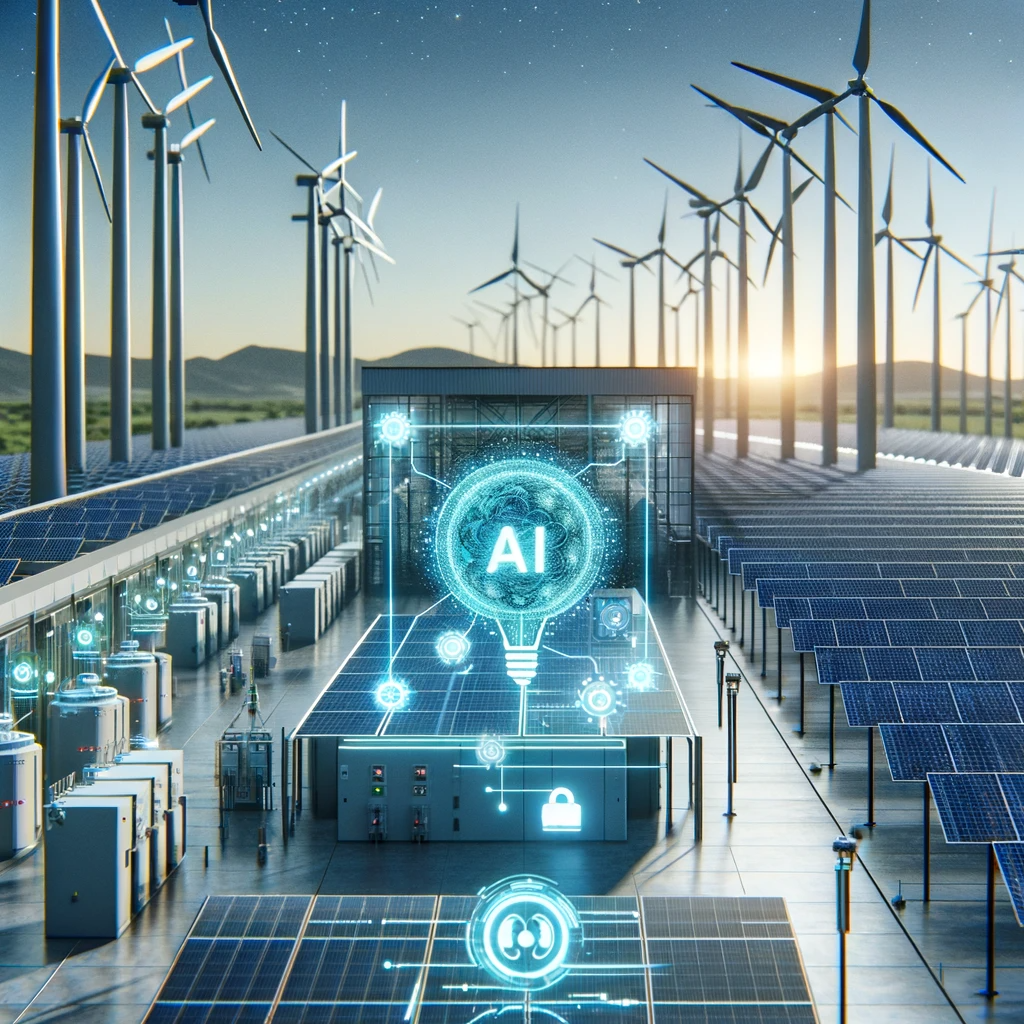Renewable energy sources hold the promise of a sustainable future, but their efficiency and integration into the power grid present complex challenges. Artificial Intelligence (AI) has emerged as a game-changer in harnessing the full potential of renewable energy. In this three-part series, we will explore how AI can optimize renewable energy sources and revolutionize sustainable energy management.
AI in Energy Forecasting
Enhancing Renewable Resource Prediction
AI algorithms analyze vast datasets, including weather patterns and historical energy production, to predict renewable resource availability with unprecedented accuracy. This enables better planning and grid integration.
Maximizing Solar Energy
AI-driven solar forecasting improves the efficiency of photovoltaic systems by predicting cloud cover and adjusting energy production accordingly. This reduces wastage and ensures a stable energy supply.

AI in Energy Production
Wind Farm Optimization
AI optimizes wind turbine operations by predicting wind patterns and adjusting blade angles in real-time. This maximizes energy generation while minimizing wear and tear.
Smart Grid Management
AI algorithms manage the distribution of energy from diverse renewable sources, ensuring a stable power supply. They can also detect and respond to grid disturbances instantly.
AI in Energy Storage
Efficient Battery Management
AI monitors battery health, predicts degradation, and optimizes charging and discharging cycles. This extends the lifespan of energy storage systems and reduces replacement costs.
Grid-Scale Energy Storage
AI-assisted grid-scale energy storage solutions enhance the reliability of renewable energy sources by storing excess energy during peak production and releasing it when needed.
AI in Wind Energy
Case Study 1: Vattenfall’s Wind Farm Optimization
Vattenfall, a Swedish energy company, employs AI to optimize the performance of its wind turbines. AI algorithms analyze weather data, turbine sensor readings, and historical energy production to predict wind patterns and adjust each turbine’s blade angle in real-time. This ensures optimal energy generation while minimizing maintenance costs.
Case Study 2: DeepMind’s AI for Wind Energy Prediction
DeepMind, a subsidiary of Alphabet (Google’s parent company), developed an AI system that predicts wind patterns and energy output for wind farms. In collaboration with the U.S. National Renewable Energy Laboratory, their AI model improved wind energy forecasting accuracy by 20%. This enhanced predictability enables grid operators to balance energy supply and demand more effectively.
AI in Solar Energy
Case Study 3: Solar Forecasting with IBM’s Watt-sun
IBM’s Watt-sun is an AI-powered solar forecasting system that combines weather data, satellite imagery, and machine learning to predict solar energy production. By accurately forecasting cloud cover and sunlight availability, Watt-sun helps solar power plants optimize energy production and grid integration.
Case Study 4: Google’s Project Sunroof
Google’s Project Sunroof uses AI and satellite imagery to assess the solar potential of individual rooftops. By analyzing factors like roof orientation, shade, and local weather conditions, it helps homeowners make informed decisions about installing solar panels, contributing to the growth of residential solar power.
AI in Energy Storage
Case Study 5: Tesla’s Autobidder
Tesla’s Autobidder is an AI-powered energy management platform that optimizes the operation of its Powerpack and Megapack energy storage systems. Autobidder buys low-cost electricity during off-peak hours and sells it during peak demand, making energy storage more economically viable while stabilizing the grid.
Case Study 6: Energy Vault’s Gravity-Based Storage
Energy Vault utilizes AI to manage its innovative energy storage solution based on stacking concrete blocks. AI algorithms control the precision of block stacking, ensuring efficient energy capture and release. This technology provides a grid-scale, environmentally friendly alternative to conventional batteries.
These real-world examples demonstrate how AI is revolutionizing renewable energy production, improving grid stability, and making sustainable energy more accessible and cost-effective.
AI for Grid Integration
Enhancing Grid Reliability
AI algorithms ensure a stable energy supply by managing the integration of variable renewable sources into the power grid. They predict energy generation, manage fluctuations, and prevent grid disturbances, making renewable energy more dependable.
Microgrid Optimization
AI optimizes microgrids, small-scale energy systems that can operate independently or in conjunction with the main grid. By managing energy production, consumption, and storage, AI helps microgrids maximize the use of renewable energy.
AI in Energy Efficiency
Smart Buildings and Cities
AI-powered smart building management systems optimize energy consumption by adjusting lighting, heating, and cooling based on occupancy and weather conditions. Similarly, AI-driven smart cities use data analytics to reduce energy waste and enhance sustainability.
Industrial Energy Management
AI helps industries optimize energy use by analyzing production processes and identifying opportunities for efficiency improvements. This reduces energy costs and carbon emissions.
AI and Decentralized Energy
Peer-to-Peer Energy Trading
Blockchain technology combined with AI enables decentralized energy trading among prosumers (those who both produce and consume energy). This empowers individuals and communities to trade surplus renewable energy directly, fostering energy independence.
AI-Managed Virtual Power Plants
Virtual power plants consist of distributed energy resources, such as solar panels and batteries, managed as a single entity by AI algorithms. These systems stabilize the grid, reduce peak demand, and enhance energy reliability.

AI for Policy and Decision-Making
Data-Driven Policymaking
Governments and energy regulators use AI to analyze energy data and formulate policies that promote renewable energy adoption and grid modernization. AI-driven insights inform sustainable energy strategies.
Investment and Financing
AI analyzes financial and environmental data to assess the feasibility of renewable energy projects. This helps investors and financial institutions make informed decisions, channeling funds into green energy initiatives.
Conclusion
Artificial Intelligence has emerged as a powerful catalyst for unlocking the full potential of renewable energy. From accurate resource prediction to optimizing energy production, storage, and grid integration, AI is reshaping the energy landscape and driving the transition to a sustainable, green future.
As we look ahead, the continued development and responsible use of AI in renewable energy hold the promise of reducing carbon emissions, combating climate change, and ensuring a cleaner, more sustainable planet for future generations.
Thank you for joining us on this journey through the intersection of AI and renewable energy. Stay informed and engaged as we navigate the evolving landscape of technology and its impact on our sustainable energy future.
